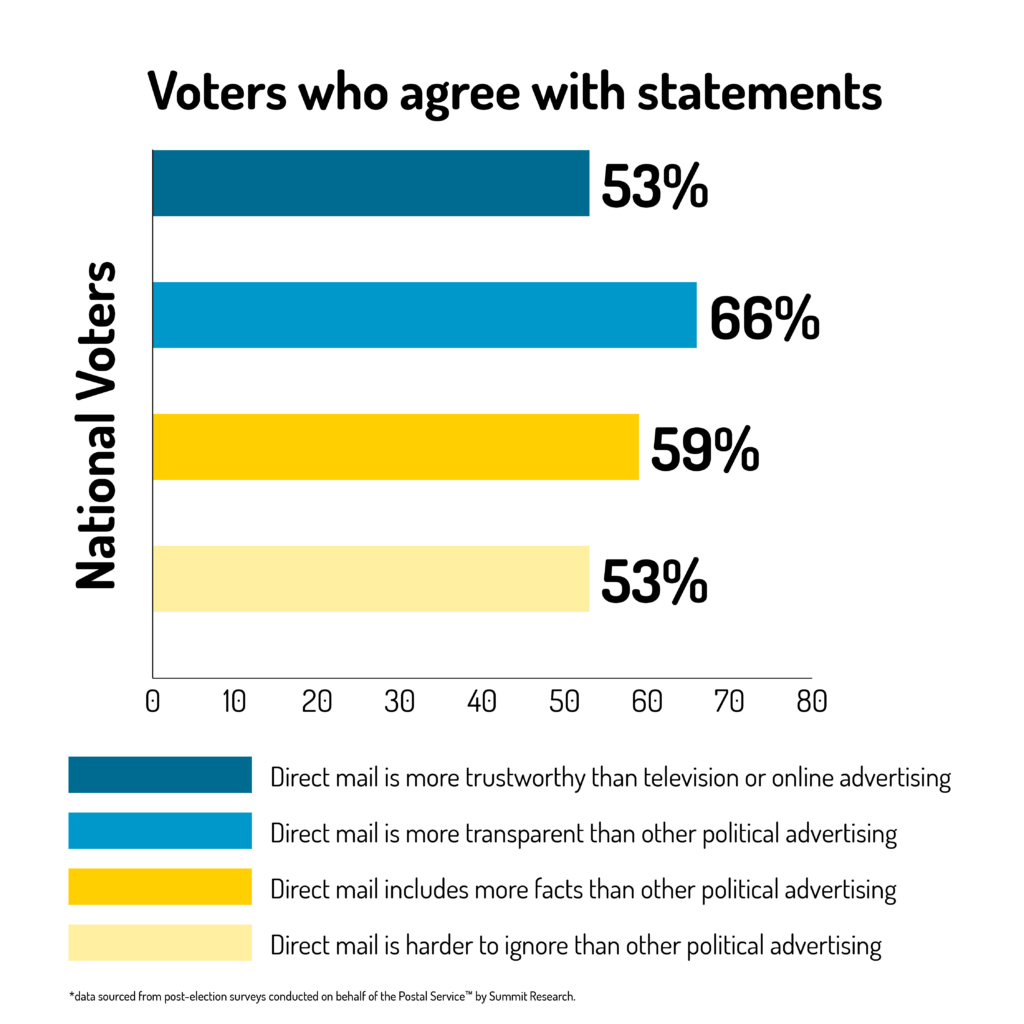The Impact of Direct Mail on Voter Behaviour
By: EmMa Matern
May 10, 2024Introduction
Exploring the impact of direct mail on voter behaviour brings us to an intriguing aspect of political campaigning. Direct mail campaigns possess a unique influence over voters, characterized by their tangible presence, perceived authority, and ability to personalize messages. Strategic placement of calls to action, personalized content, and the respectful, non-intrusive approach, direct mail emerges as a compelling tool capable of shaping voter turnout, support, and candidate recognition, shaping the outcomes of elections.
Key Points
1. Why do voters trust direct mail?
2. How does targeted messaging and personalization contribute to my campaign’s effectiveness?
3. How can I build name recognition in my campaign?
4. How does direct mail impact voter behaviour?
5. Where can I communicate my Call to Action in my direct mail campaign?
1. Why do voters trust direct mail?
Direct mail pieces possess a perceived authority that sets them apart from other communication media. People of all ages tend to trust mail, viewing it as a credible and official source of information. The tangible nature of direct mail contributes to its credibility, as recipients can physically hold and examine the materials. Direct mail can enhance its legitimacy by incorporating handwritten elements, demonstrating to voters that the candidate is investing extra time and care into communicating with them. Direct mail’s non-invasive nature is a key factor in fostering trust. By respecting recipients’ autonomy and delivering messages in a non-intrusive manner, direct mail builds confidence and credibility among voters.
2. How does targeted messaging and personalization contribute to my campaign’s effectiveness?
The connection between your message and the voter is strengthened when it’s relevant to them. By addressing them by name or referencing their past interactions or preferences, you demonstrate understanding and value for them as individuals. This personalization builds connection, fostering trust and loyalty, and increasing their likelihood of supporting your candidacy. Personalized messages are inherently more memorable than generic ones. When voters feel personally addressed and their specific needs or interests acknowledged, they are more likely to remember your campaign and its key messages. This personalized approach is critical in competitive races, where standing out is crucial. In down ballot races where the public is less aware of candidates and their positions, personalized direct mail can be very effective.
3. How can I build name recognition in my campaign?
When designing your campaign pieces, consistency is key to maintaining your specific brand. Ensure that your logos, fonts, and colours remain consistent throughout all materials. This uniformity reinforces your visibility, making your campaign instantly recognizable to voters. Utilize targeted direct mail campaigns as a strategic approach to reach specific voter demographics or geographic areas. Craft compelling messages and visuals that highlight your candidacy and key campaign priorities, capturing voters’ attention and resonating with their interests.
Consider incorporating handwritten elements into your mail pieces for an extra touch of authenticity. This personalization can help your campaign stand out and establish a genuine connection with voters. To enhance accessibility and engagement across all age groups, consider using QR codes in your mailers. These codes can direct recipients to donation pages or provide additional information about your campaign, ensuring that everyone can easily access and interact with your message. To learn more about incorporating digital elements in your direct mail, check out our blog Navigating the Digital Era: Reimagining Direct Mail.

4. How does direct mail impact voter behaviour?
Amongst all the digital clutter, direct mail stands out as the best reminder of upcoming elections and encourages voter turnout.
According to a survey by the USPS, 80% of voters agree that direct mail increases awareness of the candidates running for office.
This form of communication often includes crucial information about voting logistics, such as polling locations, hours of operation, and voting procedures. By providing this information in advance, direct mail helps reduce barriers to participation and motivates voters to cast their ballots.
One of the strengths of direct mail is its ability to personalize messages and target specific voter demographics. Campaigns can tailor mailers based on factors like past voting behaviour, demographics, and interests. Personalized messages that address recipients by name and speak to their concerns are particularly effective in motivating voter turnout.
5. Where can I communicate my Call to Action in my direct mail campaign?
Your Call to Action (CTA) is a pivotal element of your direct mail campaign, and its strategic placement can significantly impact its effectiveness. Throughout your campaign, you can position your CTA in multiple strategic locations to ensure it’s easily discoverable and understandable for recipients.
At the front of the envelope, consider including a teaser or headline to grab recipients’ attention and prompt them to open the mail. This initial impression can serve as a concise version of your CTA or pose a compelling question that sparks curiosity.
Within the main letter or brochure, prominently place your primary CTA at the top as a headline. Use clear and attention-grabbing language that precisely communicates the action you want recipients to take.
Reinforce your CTA throughout the body copy of your direct mail piece. Provide additional context and motivation for recipients to act, ensuring that your message resonates and prompts action.
Utilize highlight boxes or bullet points to draw attention to your CTA within the body copy. Ensure that it stands out visually and is easy to locate for quick reference.
Incorporate relevant images or graphics that support your CTA and reinforce its message. Visual elements can enhance the effectiveness of your CTA by making it more memorable and engaging, further motivating recipients to respond.
By strategically placing your CTA in various locations and utilizing visual elements effectively, you can maximize the impact of your direct mail campaign and drive desired actions from recipients.
Conclusion
Direct mail’s impact on voter behaviour is multifaceted and significant. Its perceived authority, tangibility, and non-intrusive nature contribute to its effectiveness as a communication medium. Through targeted messaging, personalization, and strategic placement of calls to action, direct mail can influence voter turnout, support, and name recognition, ultimately shaping the outcomes of political campaigns.


